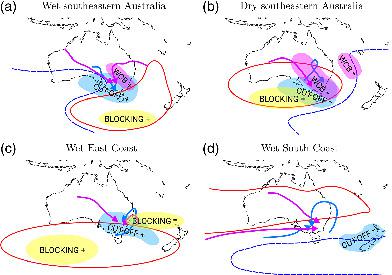当前位置:
X-MOL 学术
›
Q. J. R. Meteorol. Soc.
›
论文详情
Our official English website, www.x-mol.net, welcomes your
feedback! (Note: you will need to create a separate account there.)
A weather system perspective on winter–spring rainfall variability in southeastern Australia during El Niño
Quarterly Journal of the Royal Meteorological Society ( IF 3.0 ) Pub Date : 2020-05-17 , DOI: 10.1002/qj.3808 Seraphine Hauser 1 , Christian M. Grams 1 , Michael J. Reeder 2 , Shayne McGregor 2 , Andreas H. Fink 1 , Julian F. Quinting 1
Quarterly Journal of the Royal Meteorological Society ( IF 3.0 ) Pub Date : 2020-05-17 , DOI: 10.1002/qj.3808 Seraphine Hauser 1 , Christian M. Grams 1 , Michael J. Reeder 2 , Shayne McGregor 2 , Andreas H. Fink 1 , Julian F. Quinting 1
Affiliation

|
The El Niño phase of the El Niño Southern Oscillation (ENSO) is typically associated with below‐average cool‐season rainfall in southeastern Australia (SEA). However, there is also large case‐to‐case variability on monthly time‐scales. Despite recent progress in understanding the links between remote climate drivers and this variability, the underlying dynamical processes are not fully understood. This reanalysis‐based study aims to advance the dynamical understanding by quantifying the contribution of midlatitude weather systems to monthly precipitation anomalies over SEA during the austral winter–spring season. A k‐means clustering reveals four rainfall anomaly patterns with above‐average rainfall (Cluster 1), below‐average rainfall (Cluster 2), above‐average rainfall along the East Coast (Cluster 3) and along the South Coast (Cluster 4). Cluster 2 occurs most frequently during El Niño, which highlights the general suppression of SEA rainfall during these events. However, the remaining three clusters with local above‐average rainfall are found in ∼52% of all El Niño months. Changes of weather system frequency determine the respective rainfall anomaly pattern. Results indicate significantly more cut‐off lows and warm conveyor belts (WCBs) over SEA in El Niño Cluster 1 and significantly fewer in El Niño Cluster 2. In El Niño Cluster 3, enhanced blocking south of Australia favours cut‐off lows leading to increased rainfall along the East Coast. Positive rainfall anomalies along the South Coast in El Niño Cluster 4 are associated with frontal rainfall due to an equatorward shift of the midlatitude storm track. Most of the rainfall is produced by WCBs and cut‐off lows but the contributions strongly vary between the clusters. In all clusters, rainfall anomalies result from changes in rainfall frequency more than in rainfall intensity. Backward trajectories of WCB and cut‐off low rainfall highlight the importance of moist air masses from the Coral Sea and the northwest coast of Australia during wet months.
中文翻译:

厄尔尼诺时期澳大利亚东南部冬春季降水变化的天气系统观点
厄尔尼诺南方涛动(ENSO)的厄尔尼诺期通常与澳大利亚东南部(SEA)的冷季降雨量低于平均水平有关。但是,每个月的时间尺度上也存在较大的个案差异。尽管最近在了解偏远气候驱动因素与这种变化之间的联系方面取得了进展,但尚未完全理解潜在的动力过程。这项基于重新分析的研究旨在通过量化中纬度天气系统对南方冬季春季春季SEA每月降水异常的贡献来增进对动力学的理解。一个k均值聚类揭示了四种降雨异常模式,即东海岸(第3组)和南海岸(第4组)的降雨量高于平均水平(群集1),低于平均水平(群集2),高于平均降雨量。 。第2组发生在厄尔尼诺期间最频繁,这突显了这些事件期间对SEA降雨的普遍抑制。但是,在所有厄尔尼诺月份中,约有52%的地区出现了局部降雨高于平均水平的其余三个集群。天气系统频率的变化决定了各自的降雨异常模式。结果表明,厄尔尼诺1类群的海底最低切变数和暖海输送带(WCB)明显高于SEA,而厄尔尼诺2类群则明显减少得多。在厄尔尼诺3类群中,澳大利亚南部的封锁增强有利于切入底数降低,导致上升东海岸的降雨。由于中纬度暴风道向赤道移动,因此厄尔尼诺第4组南海岸沿线的正降雨异常与额叶降雨有关。大部分降雨是由WCB和临界低点产生的,但各组之间的贡献差异很大。在所有集群中,降雨异常的产生更多是由于降雨频率的变化而不是降雨强度造成的。WCB的后退轨迹和断断续续的低降雨突显了在潮湿月份来自珊瑚海和澳大利亚西北海岸的潮湿空气的重要性。
更新日期:2020-05-17
中文翻译:

厄尔尼诺时期澳大利亚东南部冬春季降水变化的天气系统观点
厄尔尼诺南方涛动(ENSO)的厄尔尼诺期通常与澳大利亚东南部(SEA)的冷季降雨量低于平均水平有关。但是,每个月的时间尺度上也存在较大的个案差异。尽管最近在了解偏远气候驱动因素与这种变化之间的联系方面取得了进展,但尚未完全理解潜在的动力过程。这项基于重新分析的研究旨在通过量化中纬度天气系统对南方冬季春季春季SEA每月降水异常的贡献来增进对动力学的理解。一个k均值聚类揭示了四种降雨异常模式,即东海岸(第3组)和南海岸(第4组)的降雨量高于平均水平(群集1),低于平均水平(群集2),高于平均降雨量。 。第2组发生在厄尔尼诺期间最频繁,这突显了这些事件期间对SEA降雨的普遍抑制。但是,在所有厄尔尼诺月份中,约有52%的地区出现了局部降雨高于平均水平的其余三个集群。天气系统频率的变化决定了各自的降雨异常模式。结果表明,厄尔尼诺1类群的海底最低切变数和暖海输送带(WCB)明显高于SEA,而厄尔尼诺2类群则明显减少得多。在厄尔尼诺3类群中,澳大利亚南部的封锁增强有利于切入底数降低,导致上升东海岸的降雨。由于中纬度暴风道向赤道移动,因此厄尔尼诺第4组南海岸沿线的正降雨异常与额叶降雨有关。大部分降雨是由WCB和临界低点产生的,但各组之间的贡献差异很大。在所有集群中,降雨异常的产生更多是由于降雨频率的变化而不是降雨强度造成的。WCB的后退轨迹和断断续续的低降雨突显了在潮湿月份来自珊瑚海和澳大利亚西北海岸的潮湿空气的重要性。











































 京公网安备 11010802027423号
京公网安备 11010802027423号